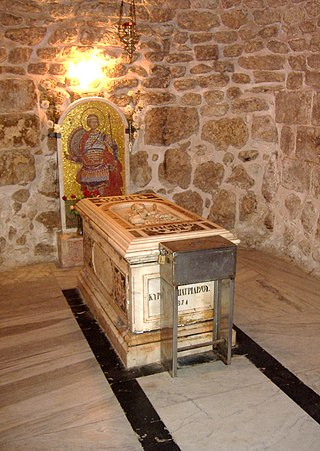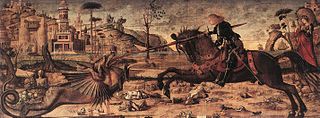
Paolo Caliari, known as Paolo Veronese, was an Italian Renaissance painter based in Venice, known for extremely large history paintings of religion and mythology, such as The Wedding at Cana (1563) and The Feast in the House of Levi (1573). Included with Titian, a generation older, and Tintoretto, a decade senior, Veronese is one of the "great trio that dominated Venetian painting of the cinquecento" and the Late Renaissance in the 16th century. Known as a supreme colorist, and after an early period with Mannerism, Paolo Veronese developed a naturalist style of painting, influenced by Titian.

In a legend, Saint George—a soldier venerated in Christianity—defeats a dragon at Dragon Hill, Uffington. The story goes that the dragon originally extorted tribute from villagers. When they ran out of livestock and trinkets for the dragon, they started giving up a human tribute once a year. This was acceptable to the villagers until a princess was chosen as the next offering. The saint thereupon rescues the princess and kills the dragon. The narrative was first set in Cappadocia in the earliest sources of the 11th and 12th centuries, but transferred to Libya in the 13th-century Golden Legend.

Jacopo Robusti, best known as Tintoretto, was an Italian Renaissance painter of the Venetian school. His contemporaries both admired and criticized the speed with which he painted, and the unprecedented boldness of his brushwork. For his phenomenal energy in painting he was termed il Furioso. His work is characterised by his muscular figures, dramatic gestures and bold use of perspective, in the Mannerist style.

Vittore Carpaccio (UK: /kɑːrˈpætʃ oʊ/, US: /-ˈpɑːtʃ-/, Italian: [vitˈtoːre karˈpattʃo]; was an Italian painter of the Venetian school who studied under Gentile Bellini. Carpaccio was largely influenced by the style of the early Italian Renaissance painter Antonello da Messina, as well as Early Netherlandish painting. Although often compared to his mentor Gentile Bellini, Vittore Carpaccio's command of perspective, precise attention to architectural detail, themes of death, and use of bold color differentiated him from other Italian Renaissance artists. Many of his works display the religious themes and cross-cultural elements of art at the time; his portrayal of St. Augustine in His Study from 1502, reflects the popularity of collecting "exotic" and highly desired objects from different cultures.

Princess and dragon is an archetypical premise common to many legends, fairy tales, and chivalric romances. Northrop Frye identified it as a central form of the quest romance.

Saint George and the Dragon is a painting by Paolo Uccello dating from around 1470. It is on display in the National Gallery, London, United Kingdom. It was formerly housed in the Palais Lanckoroński in Vienna, belonging to Count Karol Lanckoroński and sold by his son and heir Anton in 1959 through Mr. Farago. The first mention of its being there is 1898.

San Giorgio Maggiore is a 16th-century Benedictine church on the island of the same name in Venice, northern Italy, designed by Andrea Palladio, and built between 1566 and 1610. The church is a basilica in the classical Renaissance style and its brilliant white marble gleams above the blue water of the lagoon opposite the Piazzetta di San Marco and forms the focal point of the view from every part of the Riva degli Schiavoni.
Saint George and the Dragon is a medieval legend.

Marietta Robusti was a highly skilled Venetian painter of the Renaissance period. She was the daughter of Tintoretto and sometimes, is referred to as Tintoretta.

Soßmar is a village in Lower Saxony, about 30 km south of Hanover, 13 km east of Hildesheim and 12 km west of Peine, a few minutes from the national highways B494 and B65. The motorway A2 via Peine, Hämelerwald, Lehrte or Sehnde/Ilsede/Hanover can be reached in about 20 minutes and the motorway A7 via Sehnde/Ilsede/Hanover or Hildesheim/Drispenstedt in the same time.

Saint George is one of Christianity's most popular saints, and is highly honored by both the Western and Eastern Churches. A wide range of devotions, traditions, and prayers to honor the saint have emerged throughout the centuries. He has for long been distinguished by the title of "The Great Martyr" and is one of the most popular saints to be represented in icons. Devotions to Saint George have a large following among Christians, and a large number of churches are dedicated to him worldwide.

The Reverend William Holwell Carr, (1758–1830) was an English priest, art dealer, art collector and painter. His bequest of paintings was an important early addition to the collection of the National Gallery in London.

St. George and the Dragon is a tempera on canvas painting by the Italian Renaissance artist Vittore Carpaccio. It is housed in the Scuola di San Giorgio degli Schiavoni of Venice, northern Italy.
Il Paradiso is a massive oil painting on canvas that dominates the main hall of the Doge's Palace, which hosted the Great Council of Venice. It is one of the largest paintings on canvas in the world and was painted by Jacopo Robusti, known more commonly as Tintoretto. The painting features a heavenly scene with depictions of various religious figures such as the portrayal of Justina, patron saint of Padua.

Susanna and the Elders is a painting by the Venetian painter Tintoretto. Robusti, also known as Tintoretto or Il Furioso, for the energy and "fury" with which he painted, depicted both sacred and profane subjects in a period sometimes known as the Venetian “golden century”.

Diana, Princess of Wales is a 1981 painting of Diana, Princess of Wales, by the British artist Bryan Organ. It was commissioned by the National Portrait Gallery in London following Diana's engagement to Charles, Prince of Wales, in February 1981 while the gallery was under the directorship of John Hayes. It presently hangs as part of the National Portrait Gallery's permanent collection.

Saint George and the Dragon, also known as Saint George Killing the Dragon is a tempera painting by the Catalan artist Bernat Martorell, painted c. 1434 – c. 1435. It depicts the famous legend of Saint George and the Dragon, in which the Christian knight Saint George rescues a princess from a dragon.

The Stoning of Saint Stephen is an egg tempera and gold leaf painting created by Greek master Michael Damaskinos. He was a member of the Cretan school. He integrated Venetian painting with the Greek mannerisms prevalent at the time. Damaskinos was active in Heraklion, Sicily, Venice, and other parts of Italy. The Stoning of Stephen has been depicted by countless Greek and Italian painters. Saint Stephen was a protomartyr. He was the first martyr of Christianity. He was stoned to death for following the new faith. The painting is a depiction of that event.

Assumption of Mary was a painting created by Greek painter Nikolaos Doxaras. He was the son of famous Greek painter Panagiotis Doxaras. Nikolaos flourished on the Ionian Islands. He was a representative of the Heptanese School. He traveled all of the Ionian Islands painting. He spent close to a decade in Venice. He had a relationship with Johann Schulenberg. Doxaras stayed with him from 1730 to 1738 at the Palazzo Loredan. He was his confidant at the Schulenburg Art Gallery. He also painted for Schulenburg. He left Venice and continued painting all over the Ionian islands until his death. He was active from 1725 to 1775. Five of his paintings survived. Both Nikolaos and his father attempted to popularize oil painting.

Princess Tarakanova is the most famous painting by the artist Konstantin Flavitsky. Completed in 1864, the painting depicts the story of Princess Tarakanova, who was imprisoned during the reign of Empress Catherine II. Flavitsky's use of light and shadow and attention to detail in the painting earned him the title of professor of historical painting, and it remains one of his most famous works.


















